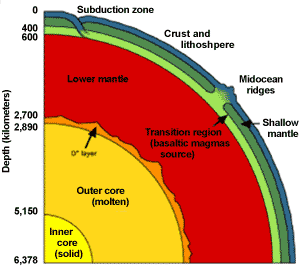Where Do Volcanic Systems Form?
Where are the steady, ready supplies of molten rock that give rise to a volcanic system?
The crust of the Earth is an extremely thin layer—like the skin of an apple or, better yet, the shell of a half-cooked egg. Picture the white of the egg as a thick liquid—this would be the Earth’s mantle—and the yolk as a solid—the Earth’s core.
|
|
|
| A cutaway diagram of the Earth shows the core, mantle, and crust. The crust and the uppermost part of the mantle make up the lithosphere, while the rest of the upper mantle forms the asthenosphere. The Mohorovičić discontinuity marks the boundary between the crust and the mantle. | |
|
Now, to complete this crude model, mentally crack the thin eggshell into tectonic plates. The Earth’s crust is broken into about 15 large slabs and dozens of smaller slabs of lithosphere (the crust plus the upper, stiff mantle). These stand-alone but tight-fitting pieces move in various directions, very slowly over the liquid mantle layer, bumping and sliding like cracked ice on a pond.
With the egg model, it’s easy to see that “magma” oozes forth from the cracks between plates. The geological process is much more complicated, but the general idea is the same for most of Earth’s volcanoes. Mount Etna and several other Italian volcanoes are perched near the boundary of the Eurasian and African plates. On the islands of Indonesia, where four tectonic plates meet and Krakatau used to exist, an astonishing arsenal of more than 125 active volcanoes threaten to explode. The small island of Java hosts 35 of them. In contrast, Australia, not far to the south of Indonesia, sits entirely on one tectonic plate, along with most of the Indian Ocean. It is the only continent that doesn’t have a single active volcano and thus contains some of Earth’s oldest rocks. (Volcanic regions have young rocks, since the crust is topped off by a fresh layer of material after each eruption.)
|
Courtesy USGS The Earth is made of layers of rock and metal, some of which are molten. The crust on which we live is a thin, brittle layer, like the shell of an egg. |
Specifically, Earth’s volcanoes form at three geological locations:
- Tectonic plates that are diverging, or spreading apart. The slowly widening rift between them allows magma to surface—the very definition of a volcano.
- Tectonic plates that are converging (meeting), forcing one plate underneath the other, called a subduction zone. Here, a continental plate is riding up over an oceanic plate.
- A hot spot in the middle of a plate. For reasons not fully understood, a plume of magma from deep in the mantle rises and punctures a tectonic plate, creating a volcano.
Now that we know where volcanoes form, we can better understand what happens when a volcano forms.
This content has been re-published with permission from SEED. Copyright © 2024 Schlumberger Excellence in Education Development (SEED), Inc.




